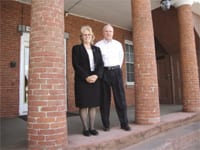Opinion Maintaining Quality Elder Care
The senior living industry is growing and changing at a phenomenal rate. Many factors are likely to drive continued industry growth, including the aging population, increased life expectancy, absence of government regulation at some levels, and a health care system intent on providing cost-effective health care in alternative settings. As it grows, the field has become increasingly competitive and diverse.
There is a wide spectrum of available services for senior citizens ranging from home care to skilled nursing facilities. Although many seniors opt to stay at home as long as possible with homecare services, assisted living is the fastest growing type of senior residence. In response to the rapid increase in numbers of seniors who can no longer live at home, but who do not yet require the services of a nursing home level of care, assisted living offers minimal assistance with activities of daily living along with the nutrition and housekeeping assistance that many seniors need.
But who exactly are the consumers assisted living facilities should target? Not too long ago, the adult children were the driving force in the senior living industry. Now, the senior population is becoming better informed and more aware of available options. Today’s 70-, 80-, or 90- year-old is not the stereotypical frail, tired elder sitting in a rocking chair all day. Today’s senior citizen demands proactive health care and has expectations of quality services. Health care professionals and third-party payers are encouraging this trend, and are looking for facilities that support active aging.
Take a look at the advertisements for senior living facilities, for instance. Everyone offers beautiful buildings, lovely landscaped grounds, spacious dining rooms, housekeeping services, and opportunities for socialization. What is going to differentiate one facility from all the others? Does it matter if one dining room chandelier is bigger and brighter than the one in the facility down the road?
Because of the rapid growth of assisted living, regulations at both federal and state levels are being examined. Seniors who are more frail and dependent are often being admitted to this level of care. In response to a series of negative newspaper articles in May of this year many consumers, ranging from senators to physicians, called for tighter reins on the assisted living industry. They are looking specifically for quality controls and procedures for addressing complaints. The industry needs to start setting standards for itself now.
What is quality in reference to senior living? What seems at first to be an easy definition becomes more difficult when the number of different consumers is taken into account. The bottom line is that the senior is the consumer that matters most — all the others are really proxies for that person. Quality gives each individual the highest level of health and independence possible.
It has become imperative to establish a reliable, valid method for measuring and monitoring the quality of care provided in senior living facilities. Many facilities feel that they do this by sending out questionnaires on an annual basis; but how can they know who filled out these surveys? It may be family members or well-meaning friends that tried to save Mom the aggravation. Even then, there is only about a 15-20{06cf2b9696b159f874511d23dbc893eb1ac83014175ed30550cfff22781411e5} return rate. This isn’t reliable or useable data for an entire facility. But some sites then manipulate this small amount of data to make it appear that their communities are superior and quality driven. It is important to develop consistent tools and use standard measurements, such as the Geriatric Depression Scale and the Mini Mental Status Exam, which can be accurately compared.
Quality is also measured by the commitment of the staff. Good staff retention is a mark of a facility where the quality of care matters. And employees who feel they are listened to and appreciated will want to stay at such a facility. Rewards or recognition for a commitment to quality are much more effective than automatic increases.
Activities in a quality facility are structured to focus on all six dimensions of wellness. The individual is recognized for needing stimulation and nurture physically, intellectually, socially, spiritually, emotionally, and vocationally. All people have the need to feel useful and challenged. Programs are so much more meaningful when they are focused on individuals’ abilities and knowledge rather than on filling time.
The face of senior living is changing. The focus is on the individual. The next generation is savvy, healthy and knowledgeable. There are more than 70 million Americans, representing one-third of the current population, turning 65 by 2030. Are we ready for the Baby Boomers?
Sarah Gilmore and Bette Trenholm of The Next Mile LLC, a New England-based consulting firm offering quality and wellness assessments, have a combined eleven years of working with management, staff and residents in the assisted living industry. They can be reached via The Next Mile Web site, www.thenextmile.com.


Comments are closed.